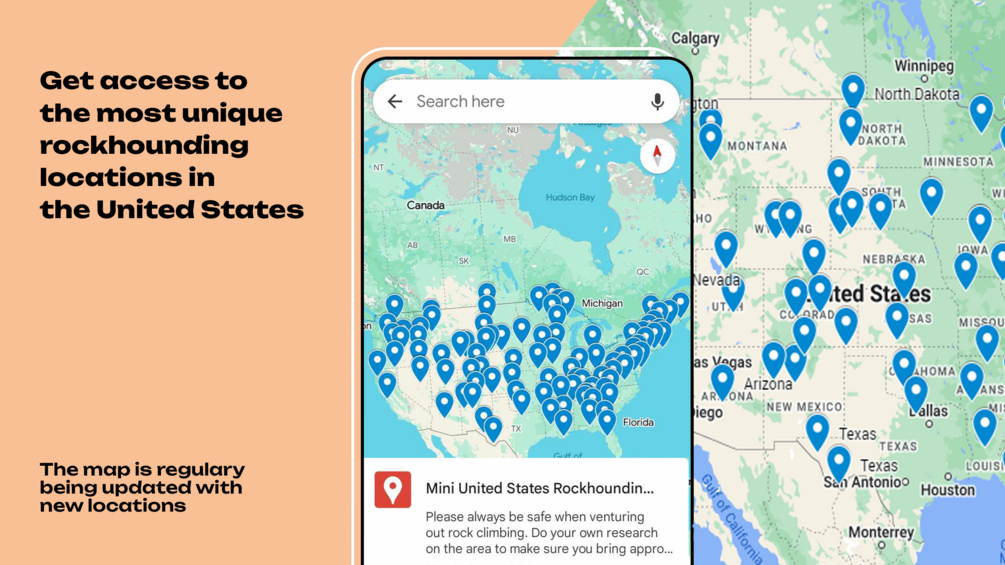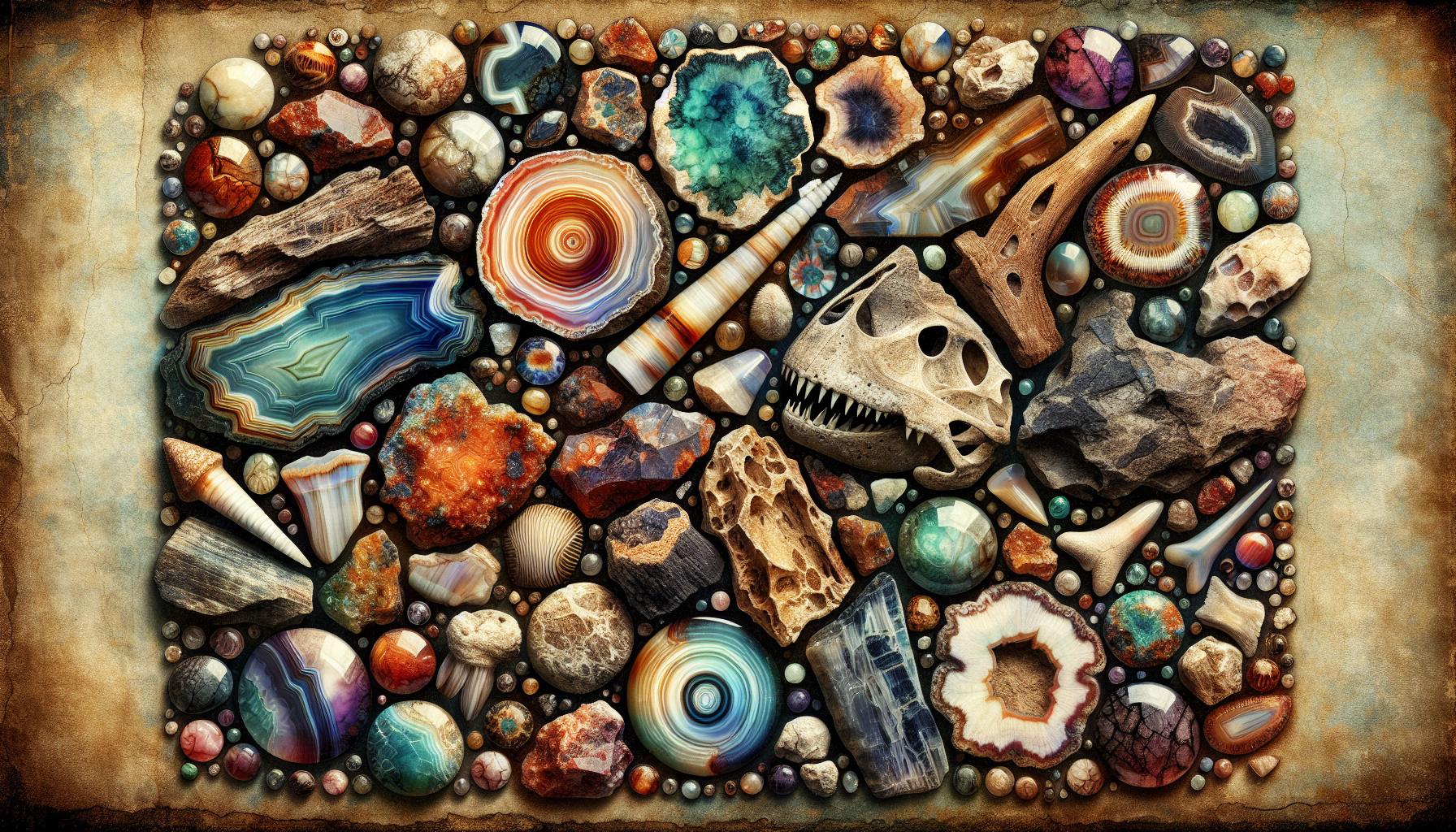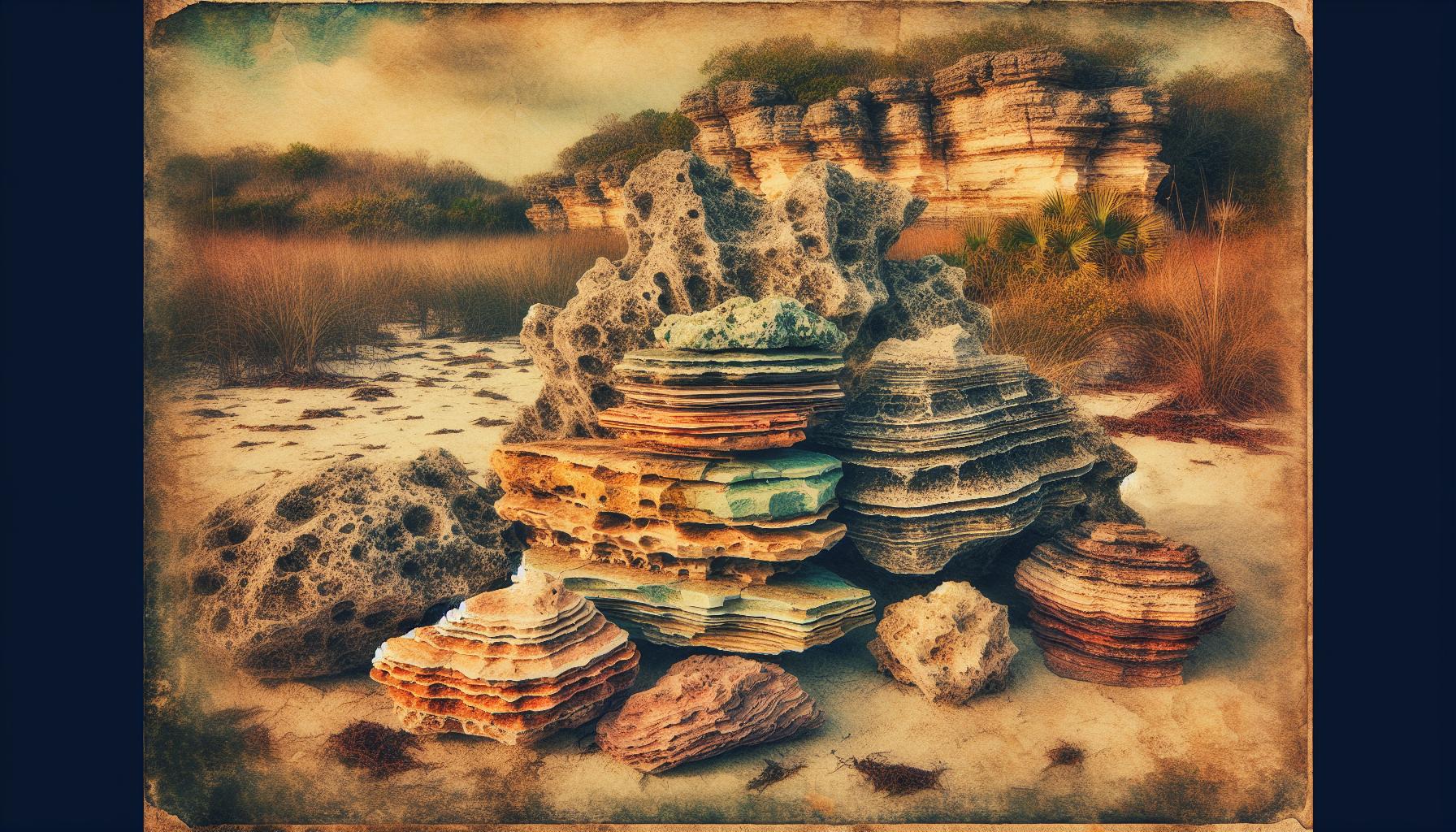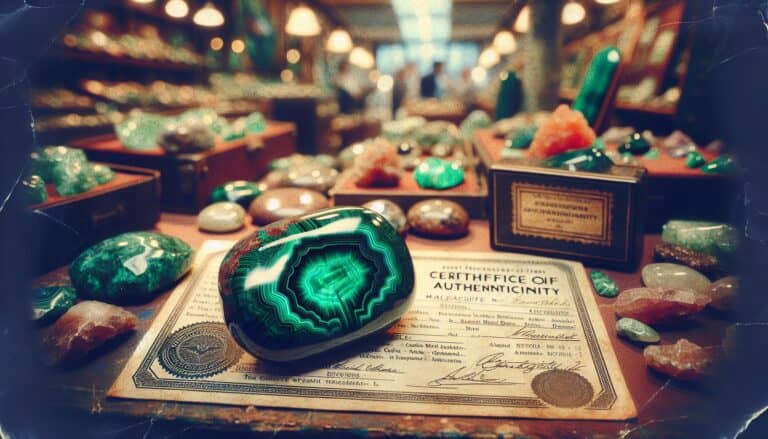Ready to uncover Florida’s hidden gems—literally?
You’re in for a treat as the Sunshine State isn’t just about sandy beaches and theme parks. It’s a haven for rockhounds looking to add to their collection.
From the Panhandle to the Keys, Florida offers unique spots brimming with geological treasures.
You’ll find everything from ancient fossils to colorful agatized coral. Get your digging tools ready; it’s time to explore the best places for rockhounding in Florida and discover what incredible finds await you.
Florida offers unique rockhounding experiences, from Rucks Pit’s calcified clams to Fort Drum Crystal Mine’s hourglass-shaped crystals. Key finds include fossils at Falls of the Ohio State Park, geodes at White River North Fork, and agatized coral in Withlacoochee State Forest.
Get our FREE United States Rockhounding Map HERE

Florida Rockhounding Locations
When you’re on the hunt for geological wonders, Florida beckons with a variety of locales that cater to rockhounds of all levels. Rucks Pit in Okeechobee is a dream destination for fossil enthusiasts. Diving into their spoil piles, you might uncover calcified clams embedded with crystals, truly a unique addition to your collection.
Venture to Fort Drum Crystal Mine in Fort Drum to sift through dirt for hourglass-shaped crystals. Their natural beauty is astounding and well worth the digging effort. Though not as frequently visited, Peace River is ideal for finding shark teeth, which tell the story of Florida’s ancient marine life.
Don’t overlook the Withlacoochee State Forest, where geodes and chert are hidden treasures amongst the forest’s natural beauty. Nearby, in the beds of the Withlacoochee River, agatized coral and colorful chalcedony await the patient rockhound.
For a glimpse of prehistoric Florida, head to Venice Beach, where fossilized shark teeth are often found right in the wet sand. It’s a perfect locale for a fun day in the sun paired with the excitement of discovering remnants of ancient creatures.
Lastly, The Keystone Pit near Tampa offers a rare chance to find agatized coral and petrified wood. The treasures you unearth will serve as a testament to your rockhounding adventure in the Sunshine State.
Each location provides different materials and experiences:
- Fossils: Rucks Pit, Peace River, Venice Beach
- Crystals: Fort Drum Crystal Mine
- Shark Teeth: Peace River, Venice Beach
- Agatized Coral and Chalcedony: Withlacoochee State Forest, Keystone Pit
- Geodes & Chert: Withlacoochee State Forest
As permits and regulations may apply, always check with the site management before planning your trip. Remember to pack your digging tools, sunscreen, and a good sense of adventure as you explore these rockhounding hotspots.
What Gemstones are Found in Florida?

When you’re rockhounding in the Sunshine State, you’re in for a colorful treasure hunt. Florida may not be synonymous with gemstone mining, but you’ll be surprised at the array of gems lurking beneath its surface.
Agate, particularly the variety known as “turritella,” is a sought-after gem in Florida. Found in select riverbeds and streams, these agates are characteristically filled with fossilized snail patterns, creating unique and intricate designs that are highly prized among collectors.
In addition to agate, the state hosts a variety of chert—a microcrystalline quartz beloved for its workability and use in creating spark-based fire starters. Chert can be found in the northern parts of Florida and is especially abundant in areas known for geode and fossil deposits.
If you’re on the prowl for something truly distinctive, Florida is one of the few places where you can find agatized coral and petrified wood. These semi-precious stones are remnants of ancient forests and coral reefs, transformed over millions of years into stunning, stone-like materials that captivate jewelers and collectors alike.
Florida is also a hotspot for fossilized shark teeth, which, while not gemstones in the traditional sense, are highly collectible and can be polished to a gleam that rivals many mineral-based gems. The fossilized teeth, remnants of the myriad species that have swum Florida’s prehistoric waters, are especially abundant in Venice Beach, earning it the nickname “Shark Tooth Capital of the World.”
Lastly, for enthusiasts interested in a bit more sparkle, there are the quartz minerals. Ranging from clear to smoky, these quartz crystals are scattered throughout the state, with certain locations like Fort Drum Crystal Mine giving visitors the chance to unearth their very own.
What Sedimentary Rocks You Can Find in Florida?

When you’re scouring the terrain of Florida, you’re likely to encounter a fascinating assortment of sedimentary rocks. One of the most common types you’ll find is limestone. Formed from the shells and skeletal fragments of marine organisms, limestone in Florida often contains remnants of ancient coral reefs, offering an intriguing glimpse into the prehistoric marine life of the region.
Alongside limestone, coquina is another sedimentary rock that may pique your curiosity. Coquina, a porous and lightweight stone, is composed almost entirely of shells and coral. This rock is not just a marvel for rockhounds but it’s also an important historical and cultural artifact, as it was used to build the Castillo de San Marcos National Monument in St. Augustine.
Florida’s sedimentary rock collection wouldn’t be complete without mentioning dolostone. Unlike limestone, dolostone contains a higher percentage of the mineral dolomite, which gives the rock its durability and distinctive texture. You might stumble upon this rock in central Florida, where it forms a part of the state’s bedrock.
Watch for sandstone as well. Although not as prevalent as limestone, sandstone deposits do exist in Florida. The natural cementing of sand grains over time gives rise to sandstone, which can vary in color from yellow and red to brown, depending on the minerals present during its formation.
Here’s a brief rundown of these sedimentary rocks you might find:
- Limestone: Rich in marine fossil fragments
- Coquina: Composed of shells and coral, and historically significant
- Dolostone: Contains a higher percentage of dolomite for durability
- Sandstone: Formed from cemented sand grains with variable colors
Remember, identifying these rocks can be a rewarding experience, but it’s important to research and respect the rules set out by the local Florida state parks or preserves. Happy rockhounding and keep your eyes peeled for these sedimentary treasures scattered throughout Florida’s diverse geological landscape.
What Metamorphic Rocks are found in Florida?
Florida might not be the first place you think of when looking for metamorphic rocks, yet it’s home to some unique geological formations. Schist and gneiss are two of the metamorphic rocks you might stumble upon in Florida, although they’re less common than the sedimentary rocks that dominate the landscape.
When you’re exploring areas like the Lake Wales Ridge, you’re traversing ancient terrains that could hold these metamorphic treasures. Schist is characterized by its foliated texture and can contain minerals like garnet, kyanite, and staurolite. Keep your eyes peeled for its distinctive shiny layers. On the other hand, gneiss, with its banded and ribbon-like appearance, tells a tale of intense heat and pressure that once molded the original rock.
Locations to Find Metamorphic Rocks
- Central Florida Highlands: Here, weathered material can uncover signs of gneiss amidst the sandy soils.
- Marianna Lowlands: This region could yield pieces of schist, albeit rarely.
Tips for Identifying Metamorphic Rocks
- Look for textured or layered appearance.
- Check for signs of mineral changes, such as new colors or patterns.
- Examine the rock for hardness; metamorphic rocks are often harder than sedimentary counterparts.
Remember, while searching for these rocks, you’re not just on a treasure hunt; you’re witnessing the ancient geological processes that shaped Florida millions of years ago. Metamorphic rocks, although not as plentiful as sedimentary varieties in Florida, offer a window into the Earth’s dynamic history. Keep in mind that these rocks may not be as visible on the surface as other types and may require a bit of digging or visiting specific outcrops.
Essential Field Equipment
To aid in your search for metamorphic rocks, here’s some equipment you might need:
- Rock Hammer: A must-have for chipping away samples.
- Hand Lens: To inspect the finer details of texture and mineral content.
- Field Guidebook: A good guidebook can help distinguish between rock types.
Always respect private property rights and environmental regulations while rockhounding and remember to fill any holes you dig. Happy hunting and enjoy the adventure that Florida’s geology has in store for you.
What Igneous Rocks can You Find in Florida?
Igneous rocks, formed from the cooling and solidification of magma or lava, are a rarity in Florida due to the state’s geological history. However, Florida does have its share of this rock type, albeit lesser-known and not as widespread as sedimentary and metamorphic rocks.
Your hunt for igneous rocks in Florida will largely center on basalt and rhyolite. These two types can be encountered, especially in areas where ancient volcanic activity may have occurred. When exploring, look for areas where tectonic activity or past volcanic events are noted in geological surveys.
Here’s a list of places and the type of igneous rocks you might find there:
- Basalt:
- Rhyolite:
It’s worth mentioning that finding igneous rocks in Florida is an exception rather than the norm. Most such specimens have been transported to the region through ancient volcanic ash deposits or through the slow process of continental drift.
For those interested in adding igneous rocks to their collection, it’s recommended to visit local rock shops for pieces that may have been imported from other states where these rocks are more prevalent. Here you can find specimens like obsidian or pumice, which are not naturally occurring in Florida but can provide a fascinating contrast to the more commonly found sedimentary and metamorphic rocks.
Remember, whenever you’re out rockhounding, it’s paramount to carry out your activity responsibly and sustainably. Make sure you’re familiar with the local laws and regulations, and always obtain permission before entering private lands or protected areas. Keep in mind that certain locations might be off-limits to collecting, so always do your research before setting out.
Panning for Gold in Florida
While Florida might not be the first state that comes to mind when you think of gold panning, it’s an activity that offers a unique combination of excitement and potential reward. Although Florida’s history with gold isn’t as rich as that of other states, there are still opportunities for you to try your hand at panning and potentially find some small flakes or gold dust.
Most of the gold found in Florida is very fine, so you’ll need patience and the right techniques to increase your chances of success. Begin your adventure by heading to streams in known gold-bearing areas. North Florida’s streams, for example, have histories of small gold discoveries.
When you’re ready to start, remember to choose a pan with ridges, as they can help separate gold from other materials. Here’s a quick guide to get you started:
- Fill the pan with sediment from the streambed
- Submerge it in water and shake it gently to allow gold to sink to the bottom
- Gradually remove the lighter materials from the top
- Swirl the remaining material to locate tiny gold particles
The process can be meditative and offers a tangible link to the prospectors of the past. Keep in mind that much of the gold in Florida is fine placer gold, making it a challenge to recover in large quantities. But don’t let this deter you—every small flake you find is a treasure in its own right.
As you embark on this quest, it’s essential to be aware of local laws and property rights. Always seek permission to pan on private lands and ensure you are not violating any environmental laws. Public lands and national forests are often safe bets, but double-check with local authorities before commencing.
If you’re looking for specific locations to start panning, the northern parts of the state, particularly around the Appalachicola River, have proven to be more fruitful. Additionally, tributaries and creeks that feed into major rivers might hold gold deposits washed down from eroding rock formations upstream.
Gear up with a sturdy pan and a sense of adventure, and stay persistent. Who knows, you may just get lucky and catch a sparkle of gold amidst the grains of sand.
Rocks and Minerals Found in Florida
Florida’s terrain, largely sedimentary in nature, is more than just a gold panner’s delight. You’ll find a surprisingly diverse array of rocks and minerals if you know where to look. Limestone and dolomite underlie much of the state, but Florida isn’t all about sedimentary rocks. Igneous rocks like basalt and rhyolite, though not as common, are tucked away in specific locales, waiting for the keen-eyed rockhound.
Your hunt for minerals might lead you to discover the fascinating phosphates, especially in the Bone Valley region. These rocks are remnants of prehistoric sea life and are central to Florida’s robust mining industry. Notably, the state supplies most of the nation’s phosphate needs and a significant percentage globally. Agatized coral, Florida’s state stone, can be found scattered throughout the state. This unique gemstone forms when silica in the ocean water hardens, replacing the coral with a harder, more resilient stone.
Besides these, quartz crystals and calcite can be unearthed in several Florida localities. While quartz is common worldwide, finding it in its crystal form is always a treat for rockhounds. It’s transparent to translucent, with a glass-like luster that can make your finds sparkle in the sunlight.
If you’re exploring the northern part of the state, keep an eye out for chert, a fine-grained silica-rich microcrystalline type of quartz that varies in color from white to black. It’s often found in the limestones of this area and can sometimes contain fossils, adding an extra layer of intrigue to your search.
For a comprehensive guide on where exactly to find these rock and mineral treasures, let’s dig deeper into the specific locations and the type of gear you’ll need to help maximize your chances of success. Always remember, each adventure could bring you closer to Florida’s hidden geological jewels. Bring your curiosity and perhaps a bit of patience; who knows what you’ll unearth next.
Where Can I Find Fossils in Florida?
Florida’s landscape provides a unique bounty for fossil enthusiasts and paleontology aficionados. While searching for geological treasures, don’t miss out on the thrill of uncovering Florida’s prehistoric past. The state is renowned for its wealth of fossilized remains, stemming from its history beneath ancient seas and abundant wildlife.
One of the most famous sites for fossil hunting is the Peace River, a wellspring of ancient shark teeth, including those from the gargantuan Megalodon. You’re also likely to come across bones of vertebrates like fish, turtles, and mammals. The river’s sandy beds make a great area to sift through, especially during the dry season when water levels are low, granting better access to fossil layers.
Rucks Pit in Fort Drum is another notable location where you’ll find fossilized clam shells embedded with calcite crystals. While these fossils are plentiful, always check the current regulations and guidelines, as some areas may require permits or have restricted access.
The beaches near Venice, often referred to as the “Shark Tooth Capital of the World,” are also excellent for discovering fossils. Here, you’ll uncover not only shark teeth but also ray plates and other marine fossils just by scanning the sand.
In addition, the Bone Valley region extends your fossil-hunting possibilities. While phosphates are the primary mineral product, the area also yields an abundance of fossils due to the rich deposits left behind from the Miocene Epoch. Here you can find a myriad of land and marine fossils, including those of manatees, bison, and teeth from various prehistoric creatures.
For a more structured experience, consider joining a guided fossil hunt or visiting a pay-to-dig site. These can provide you with the tools and expertise to maximize your time and potential findings.
Always remember to respect the land and local laws; take only pictures, leave only footprints, and verify any collection regulations. With these principles in mind, you’re all set for a journey back in time, delving into Florida’s ancient ecosystems through the fascinating pursuit of fossil hunting.
Florida Rockhounding Laws & Regulations
When you’re exploring the diverse geological offerings of Florida, it’s crucial to be aware of the local laws and regulations governing rockhounding. The Sunshine State has specific guidelines that ensure both your safety and the preservation of the natural environment. Abiding by these rules is not only respectful but also ensures that rockhounding remains a sustainable hobby for years to come.
First and foremost, always obtain permission before entering private property or rockhounding. This means reaching out to landowners or securing permits if required. What’s more, certain areas like national parks, state parks, and historic sites are off-limits for collecting. Make sure to check the regulations of each site beforehand as they can vary significantly.
In Florida, several areas are designated specifically for fossil collecting. The Peace River is one of these locations where you can hunt for shark teeth and other prehistoric remnants with the proper permit. These permits are often easy to obtain and are your ticket to explore and collect without legal concern. Remember, it’s your responsibility to renew these permits as they are typically valid for a single year.
For those interested in rockhounding on public lands, you’ll find different rules apply. Collecting small amounts for personal use is often allowed but removing large specimens or using heavy equipment is usually prohibited. Digging in designated wilderness areas, ecological preserves, or lands set aside for scientific study is strictly forbidden.
When it comes to Florida’s rich deposits of phosphates and the state stone, agatized coral, extra care should be taken. While these are abundant, they’re also crucial to Florida’s natural heritage. Always adhere to the Leave No Trace principles which include:
- Planning ahead and preparing
- Disposing of waste properly
- Leaving what you find
- Respecting wildlife and other visitors
Additionally, respect the regulations set forth by the** Bureau of Land Management** (BLM) and the** U.S. Forest Service** when rockhounding in areas they manage. These regulations help maintain the ecological balance and preserve the areas for future generations.
Remember, ethical rockhounding not only reflects well on the community but also ensures that you can enjoy the hobby without legal complications. Always stay informed and current on the laws, as they can and do change. After all, your experiences in Florida’s natural treasures should be as lawful as they are memorable.
Rockhounding Tips for Beginners in Florida
As you embark on your rockhounding adventure in Florida’s rich geological landscapes, it’s crucial to be well-prepared to make the most of your experience. Understanding what tools to bring, how to remain safe, and the ins and outs of the legal landscape will enhance your rockhounding journey. Here’s your essential guide to getting started.
Gearing Up: Essential Tools for Rockhounding
Rockhounding can be an incredibly rewarding hobby, but having the right tools is key. At a minimum, you’ll want to have these essentials:
- Rock Hammer: A sturdy rock hammer is your fundamental tool for breaking and splitting rocks.
- Chisels: To help extract specimens, a good set of chisels works in conjunction with your hammer.
- Safety Goggles: Protect your eyes from rock chips.
- Gloves: Durable gloves save your hands from cuts and abrasions.
- Bucket or collecting bag: To carry your finds.
- Field guidebook: Helpful for identifying rocks and minerals you come across.
These basics will set you up for a productive outing, keeping you ready to uncover hidden geological treasures across Florida’s diverse terrain.
Safety Tips While Rockhounding
Venturing into the great outdoors for rockhounding means you’ll be exposed to various environmental elements. Stay safe by following these guidelines:
- Stay Hydrated: The Florida heat can be intense, so bring plenty of water.
- Wear Appropriate Clothing: Protect yourself from the sun and rough terrain with long sleeves, hats, and sturdy boots.
- Be Aware of Wildlife: Florida is home to a variety of wildlife. Be cautious of your surroundings and give animals plenty of space.
- Inform Someone of Your Plan: Always let someone know where you’re going and when you expect to return.
By prioritizing safety, you ensure that your rockhounding adventure doesn’t turn into a rescue mission.
Legal Guidelines for Rockhounding Enthusiasts
Legal adherence isn’t just about staying out of trouble; it’s about fostering sustainable practices that allow for future generations to enjoy rockhounding as well. Keep these points in mind:
- Land Ownership: Always determine the ownership of the land you plan to explore and seek the necessary permissions.
- Collecting Limits: Some locations may have restrictions on the amount or type of material you can collect.
- Protected Areas: Familiarize yourself with areas that are off-limits to collectors, such as state and national parks.
- Fossil Permits: If you’re interested in collecting fossils, a permit may be required. Check with Florida’s state regulations before you head out.
Remember, adherence to these guidelines is not only respectful to the environment and local communities but also integral to the ethical pursuit of this fulfilling hobby. Keep up to date with all local and federal regulations to ensure your rockhounding adventure is both enjoyable and compliant.
Conclusion: Florida Rockhounding Guide & Map
Venturing into Florida’s diverse geology offers a unique adventure as you seek out basalt, rhyolite, and the coveted agatized coral.
With the Bone Valley’s phosphate treasures and the sparkle of quartz crystals, your rockhounding journey promises rich rewards. Remember to pack your tools, prioritize safety, and respect the legalities of your hobby. Florida’s terrain is waiting to reveal its hidden gems to those ready to explore.
So grab your gear and let the thrill of discovery lead the way on your next rockhounding excursion.



![Ohio Rockhounding Sites in [year]: Spots & Treasures](https://observationhobbies.com/wp-content/uploads/2024/01/vqJV6LfGkDrfpCSMU6rRr-768x439.jpg)



